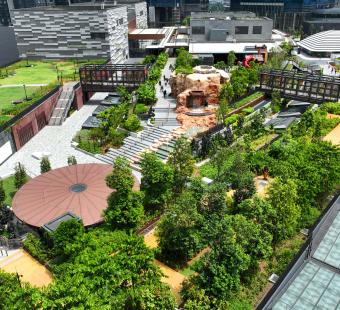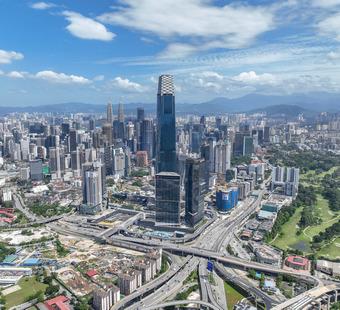The Demag CC8800-1, a giant 1,600-tonne capacity crane, comes to Kuala Lumpur city centre to assist building Malaysia’s first dedicated Financial District
A crane this size is mainly used in the construction of large industrial structures, such as oil refineries and power plants – it is almost never seen in urban developments.
“I believe this is the biggest crane being utilised in Central KL,” says Stanley Swee, the Project Manager from Tiong Woon Crane & Transport (M) Sdn Bhd, the company supplying the crane.
Connecting the dots
The TRX district is made up of two separate parcels of land. The 57-acre North side is where the International Financial District is being built. The South, a much smaller site, is separated from the main area by Jalan Sultan Ismail, the SMART Tunnel and smaller slip roads.
To connect these two sections of TRX, a 70-metre bridge, complete with its own utility tunnel, is being constructed.
“The North-South Bridge, which is both vehicular and pedestrian-friendly, will allow the South parcel access to the same seamless connectivity as the North parcel,” Tan Hwa Min, Chief Operating Officer of TRX City Sdn Bhd (TRXC) explains.
“It will also preserve the district's cohesiveness so that both sides can enjoy the same facilities such as the MRT connection, SMART Tunnel connection and the pedestrian linkage to Bukit Bintang,” he adds.
A behemoth to the rescue
This is where the giant crane comes in. Normally, a bridge of this size would only require two regular cranes to simultaneously lift the bridge’s trusses into place.
However, the TRX site has unique size constraints as it is in a city centre area with lots of crucial infrastructure around it. This means there is not enough space for two cranes to conduct tandem lifting safely.
“Because we have to avoid the Kampung Pandan roundabout flyovers and the SMART Tunnel, we need to go further away to conduct the truss launching. That’s why we needed a bigger crane capable of lifting the trusses on its own,” says Nivaraj Letchmanan, who is project managing the bridge construction for TRXC.
The decision to bring a 1,600-tonne crane to the city centre required careful planning, extra infrastructure and delicate logistical manoeuvrings.
“Before we can even transport this crane to site, we needed to build reinforced concrete foundations to support and withstand the weight of the crane above the SMART tunnel. We needed around 114 piles laid to the depth of 10 to 20 metres to achieve that.” Nivaraj added.
Even bringing the crane from Singapore to Kuala Lumpur was a feat of logistical precision. 52 trailers were required to transport the crane in parts to be assembled on site.
“Due to the site constraints and limited access, it was crucial that the parts were loaded into the trailers in a particular configuration, and then the trailers had to arrive on site in sequence to facilitate the correct assembly of the crane,” Stanley explains.
Launching the bridge trusses
To build TRX’s North-South Bridge, the abutments on each side are connected by four steel trusses, each measuring 70 metres long and weighing 220 tonnes.
Over the course of four weekend nights, the trusses were lifted into place by the Demag CC8800-1 crane in a careful procedure designed for maximum safety and minimum disruption.
“In order to do the truss launching safely, we need to close the Kampung Pandan roundabout, the SMART Tunnel, and a handful of other smaller roads,” Nivaraj says.
“So, we do it at night when there’s less traffic, and we choose Friday and Saturday nights because if we need to prolong the traffic diversions, the next day is a non-working day. This way, we minimise the interruption to road users,” he reasons.
Each night of the launching, the process begins with the crane lifting the steel truss one metre above ground, which is then stabilised by the riggers and held in place for 30 minutes. This is to check that all truss connections and lifting gear are working correctly.
Once the all-clear is given, the truss is swung into alignment before lifting, to avoid swinging the truss dangerously while in the air. Only then, is it lifted above the abutments and across the SMART Tunnel and Jalan Sultan Ismail to a height of around 6 metres. The final step is to lower the truss gently onto the abutments, and then braced into place safely.
With this unique lifting operation successfully completed, the mighty crane can return to its home in Singapore, as roadwork construction now begins on the TRX bridge.
---






